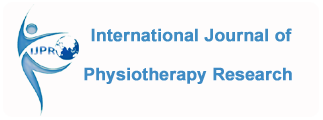IJPR.2024.146
Type of Article: Original Research
Volume 13; Issue 1 (February 2024)
Page No.: 4834-4839
DOI: https://dx.doi.org/10.16965/ijpr.2024.146
Can Brunnstrom Stages of Recovery of Hand Function Predict Functional Activities of Hand at 4 Weeks in Patients with Stroke- A Pilot Study
Anuja Rajurkar *1, Maheshwari Harishchandre 2, Suvarna Ganvir 3.
*1 PG student, Department of Neurophysiotherapy, DVVPF’s College of Physiotherapy, Ahmednagar, Maharashtra, India. ORCiD: 0009-0009-7789-7665
2 Associate Professor, Department of Neurophysiotherapy, DVVPF’s College of Physiotherapy, Ahmednagar, Maharashtra, India. ORCiD: 0000-0001-6135-9728
3 Professor and Head, Department of Neurophysiotherapy, DVVPF’s College of Physiotherapy, Ahmednagar, Maharashtra, India. ORCiD: 0000-0002-1383-6179
Corresponding Author: Anuja Rajurkar, PG Student, Department of Neurophysiotherapy, DVVPF’s College of Physiotherapy, Ahmednagar, Maharashtra, India. E-Mail: anujarajurkar0202@gmail.com
ABSTRACT
Background: Hand recovery is one of the most important treatment goal for patients with stroke. A valid and reliable measure assessing post stroke hand function is essential for appropriate clinical decision and treatment planning. Therefore, the present study aimed to find out the predictive validity of Brunnstrom Stages of Recovery of hand function for functional activities measured by ICF Codes and Sollerman Hand Function test in patients with stroke.
Methodology: 10 individuals with stroke were recruited and assessed for baseline, after 2 weeks and score after 4 weeks for Brunnstrom stage of recovery for hand, ICF codes for hand and Sollerman hand function test.
Results: Brunnstrom stage of recovery for hand and ICF codes for hand function were found to have significant negative relation between them (Picking up: -0.95, Grasping: -0.88, Manipulating: -0.87, Releasing: -0.95) whereas there was a significant positive correlation of 0.93 between BRS hand and Sollerman hand function test.
Conclusion: The present study concluded that the Brunnstrom recovery stage for hand can predict the functional use of hand in patient at 4 weeks stroke.
Keywords: Hand function, Prediction, Brunnstrom stage, ICF code, Sollerman hand function test.
REFERENCES
[1]. Coupland AP, Thapar A, Qureshi MI, Jenkins H, Davies AH. The definition of stroke. J R Soc Med. 2017 Jan;110(1):9-12.
https://doi.org/10.1177/0141076816680121
PMid:28084167 PMCid:PMC5298424
[2]. Ovbiagele B, Nguyen-Huynh MN. Stroke epidemiology: advancing our understanding of disease mechanism and therapy. Neurotherapeutics. 2011 Jul;8(3):319-29.
https://doi.org/10.1007/s13311-011-0053-1
PMid:21691873 PMCid:PMC3250269
[3]. State of World Population 2019 [Internet]. [cited 2024 Oct 25]. Available from: https://www.unfpa.org/state-world-population-2019
[4]. Suwanwela NC, Poungvarin N, Asian Stroke Advisory Panel. Stroke burden and stroke care system in Asia. Neurology India. 2016 Mar-Apr;64 Suppl:S46-51.
https://doi.org/10.4103/0028-3886.178042
PMid:26954968
[5]. Jones SP, Baqai K, Clegg A, Georgiou R, Harris C, Holland EJ, Kalkonde Y, Lightbody CE, Maulik PK, Srivastava PM, Pandian JD, Kulsum P, Sylaja PN, Watkins CL, Hackett ML. Stroke in India: A systematic review of the incidence, prevalence, and case fatality. Int J Stroke. 2022 Feb;17(2):132-140.
PMCID: PMC8821978.
https://doi.org/10.1177/17474930211027834
[6]. GBD 2019 Stroke Collaborators. Global, regional, and national burden of stroke and its risk factors, 1990-2019: a systematic analysis for the Global Burden of Disease Study 2019. Lancet Neurol. 2021 Oct;20(10):795-820.
PMID: 34487721; PMCID: PMC8443449.
[7]. Waghavkar, S.N., & Ganvir, S.S. Effectiveness of Mirror Therapy to Improve Hand Functions in Acute and Subacute Stroke Patients. international journal of neurorehabilitation, 2015;2:1-3.
https://doi.org/10.4172/2376-0281.1000184
[8]. Physical Rehabilitation, 6th edition”by Susan B. O’Sullivan, Thomas J. Schmitz et al. [Internet]. [cited 2024 Oct 25]. Available from: https://hsrc.himmelfarb.gwu.edu/books/85/
[9]. Ranzani R, Lambercy O, Metzger JC, Califfi A, Regazzi S, Dinacci D, Petrillo C, Rossi P, Conti FM, Gassert R. Neurocognitive robot-assisted rehabilitation of hand function: a randomized control trial on motor recovery in subacute stroke. J Neuroeng Rehabil. 2020 Aug 24;17(1):115. https://doi.org/10.1186/s12984-020-00746-7
PMid:32831097 PMCid:PMC7444058
[10]. Bernhardt J, Hayward KS, Kwakkel G, Ward NS, Wolf SL, Borschmann K, et al. Agreed definitions and a shared vision for new standards in stroke recovery research: The Stroke Recovery and Rehabilitation Roundtable taskforce. Int J Stroke. 2017 Jul;12(5):444-50.
https://doi.org/10.1177/1747493017711816
PMid:28697708
[11]. Brogårdh C, Persson AL, Sjölund BH. Intra- and inter-rater reliability of the Sollerman hand function test in patients with chronic stroke. Disabil Rehabil. 2007 Jan 30;29(2):145-54.
https://doi.org/10.1080/09638280600747603
PMid:17364764
[12]. Shah SK, Harasymiw SJ, Stahl PL. Stroke Rehabilitation: Outcome Based on Brunnstrom Recovery Stages. The Occupational Therapy Journal of Research. 1986 Nov 1;6(6):365-76.
https://doi.org/10.1177/153944928600600604
[13]. Safaz I, Yilmaz B, Yaşar E, Alaca R. Brunnstrom recovery stage and motricity index for the evaluation of upper extremity in stroke: analysis for correlation and responsiveness. Int J Rehabil Res. 2009 Sep;32(3):228-31.
https://doi.org/10.1097/MRR.0b013e32832a62ad
PMid:19339892
[14]. Liu Y, Liu J, Ai L, Wei Q, Liu Q, Xie S. Objective Evaluation of Hand ROM and Motion Quality based on Motion Capture and Brunnstrom Scale. In: 2019 IEEE/ASME International Conference on Advanced Intelligent Mechatronics (AIM) [Internet]. 2019 [cited 2024 Oct 25]. p. 441-6.
https://doi.org/10.1109/AIM.2019.8868793
[15]. Iokawa K, Sone T, Fujita T, Tsukada T, Kaneda M, Hasegawa K. Functional and cognitive variables predicting successful use of chopsticks or a spoon by the paretic upper extremity in patients following stroke: a cross-sectional study. Top Stroke Rehabil. 2019 Jan 1;26(1):1-5.
https://doi.org/10.1080/10749357.2018.1536021
PMid:30355062
[16]. Suzuki Y, Tsubakino S, Fujii H. Eating and Grooming Abilities Predict Outcomes in Patients with Early Middle Cerebral Infarction: A Retrospective Cohort Study. Occup Ther Int. 2020 May 11;2020:1374527.
https://doi.org/10.1155/2020/1374527
PMid:32536832 PMCid:PMC7267875
[17]. Umeki N, Murata J, Kubota S, Kogo H, Yamaguchi T, Higashijima M. Relationship Between Motor Paralysis and Impairments in Tactile Sensitivity in Elderly Stroke Patients. International Journal of Gerontology. 2018 Dec;12(4):310-3.
https://doi.org/10.1016/j.ijge.2018.03.002
[18]. Meng L, Jiang X, Qin H, Fan J, Zeng Z, Chen C, et al. Automatic Upper-Limb Brunnstrom Recovery Stage Evaluation via Daily Activity Monitoring. IEEE Trans Neural Syst Rehabil Eng. 2022;30:2589-99.
https://doi.org/10.1109/TNSRE.2022.3204781
PMid:36067100
[19]. Bhalerao G, Chaudhari M, Rairikar S. Correlation of Voluntary Control (Brunnstrom Stage of Recovery) with Activities of Daily Living (adls) and Motor Function in Stroke Patients. Journal of Orthopaedic and Rehabilitation 2016 Jan-Apr; 3(1):5-7.








